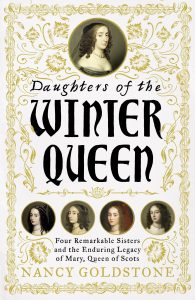Nancy Goldstone is the author of ‘Daughters of the Winter Queen: Four Remarkable Sisters, the Crown of Bohemia and the Enduring Legacy of Mary, Queen of Scots’ which was published earlier this month in the UK by Weidenfeld & Nicolson.
Nancy is also the author of ‘The Rival Queens’, ‘The Maid and the Queen: The Secret History of Joan of Arc and Yolande of Aragon’, ‘Joanna: The Notorious Queen of Naples, Jerusalem and Sicily’ and ‘Four Queens: The Provençal Sisters Who Ruled Europe.’
Buy ‘Daughters of the Winter Queen’:
Nancy’s website: Nancy Goldstone
Many thanks to Nancy for answering my questions.
Why did you choose this subject for your book?
I knew for some time that I wanted to write about Elizabeth Stuart. I found her story to be absolutely riveting. So much adventure! Imagine having to escape enemy soldiers on horseback in the winter while seven months’ pregnant! But it wasn’t until I really started researching that I realized how critical her daughters were to understanding the 17th century, how much these women influenced Western Europe politically and culturally. But no one ever talks about them, they get no credit, and so I knew I had to include them. They complete the legacy that began with Mary, Queen of Scots.
What does your book add to previous works covering these women?
Although there have been previous biographies of Elizabeth Stuart, as well as one of her eldest daughter, Princess Elizabeth, and one of Sophia of Hanover, there is nothing on the second daughter, Louise Hollandine, or on the third, Henrietta Maria. Also, mine is the first to show the interaction between all the sisters, and to unravel their various relationships. And it’s necessary to take the time to do this in order to reveal the many ways in which the female line descending from Mary, Queen of Scots helped shape the events of their time. The fact that so many people still believe that George I inherited Great Britain according to some sort of precedence, for example, is a misconception that I’m hoping Daughters of the Winter Queen finally puts to rest. It was his mother, Sophia of Hanover, who actively and successfully negotiated for the Crown. If it had been up to George I, some other family would be occupying Buckingham Palace right now.
What traits if any, did Elizabeth Stuart inherit from her grandmother Mary, Queen of Scots?
I think it is very clear that Elizabeth Stuart got her courage, persistence, and leadership qualities (as well as her beautiful auburn curls) from Mary. I am not the first biographer to note how similar these two women were. And certainly, there were no signs of these traits in her father, James I, or her mother, Anne of Denmark.
Which of Elizabeth’s daughters was the most interesting to write about?
I don’t usually like to play favorites but in this case I have to admit that Sophia, Electress of Hanover, the youngest daughter, was the most fun to write about. Her outstanding sense of humor, combined with the story of her engagement, and her take on her brother’s hilariously dysfunctional marriage, provided some much needed comic relief from the tragedy that her family regularly endured! Also, she was so intelligent, and handled all of her negotiations, including the one for the Crown of Great Britain, so deftly that I admired her greatly and this of course made it easy to tell her story.
Which daughter was the most difficult to write about?
That would have to be the second daughter, Louise Hollandine, known as Louisa. Louisa was insouciant, beautiful, enormously talented, and irresistibly full of life as a young woman but all of her hopes and dreams were frustrated. Forced to live through one terrible ordeal after another, she became bitter and this was difficult to chronicle. Such a waste of an extraordinarily free and artistic spirit!
What surprised you most researching this book?
What surprised me most was how educated all of the sisters were, and how much they pursued knowledge into adulthood. It is assumed by most historians that princesses were taught the gracious arts but not serious math, science, or philosophy. But the scholarship of both Princess Elizabeth and Sophia of Hanover contradict that assumption and Sophia ensured that her daughter, Figuelotte, was also given an outstanding education by appointing Leibniz as her tutor. I believe that this emphasis on learning, itself a function of the sisters having been raised in Holland during the Golden Age of the Dutch, was a key factor to the family’s survival and ultimate succession to the throne of Great Britain.
Which of Elizabeth’s sons was the most interesting to write about?
Oh, Prince Rupert, by all means. He was such a dashing character! I can’t believe he doesn’t already have his own Netflix series. He was brave, handsome, irreverent…his troops adored him and women followed him whenever he broke camp. I think I was a little in love with him myself when I was writing about him.
What was the legacy of Mary, Queen of Scots?
Mary’s legacy is the Crown. Like it or not, it is her descendants (including the indomitable Victoria) who have succeeded to the throne in an unbroken line all the way to the current Queen Elizabeth II. And this legacy was in no way written in stone. In fact, there were enormous obstacles to be overcome for the succession to work out the way it did. It was only through the courage and determination of her granddaughter and great-granddaughter, who were both so like Mary in everything but religion that this family prevailed.



































